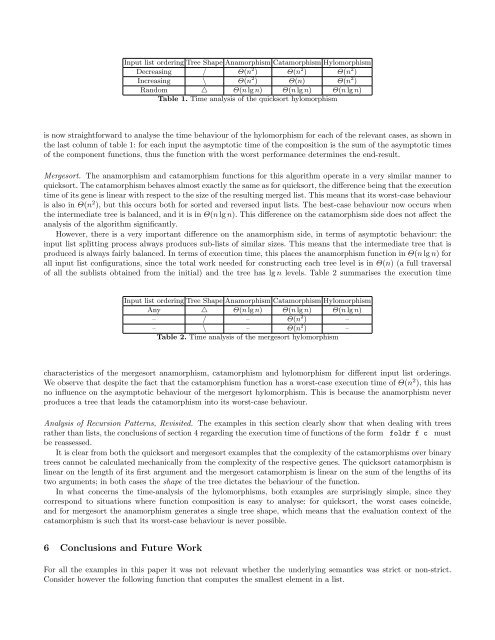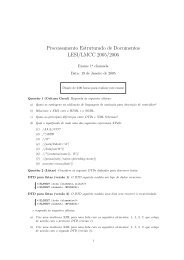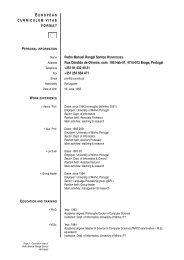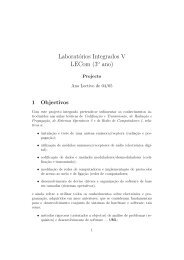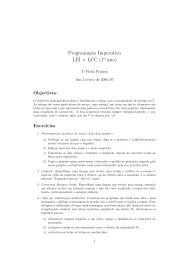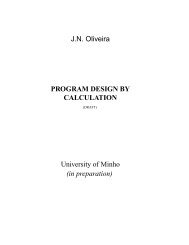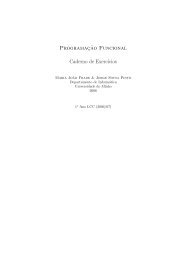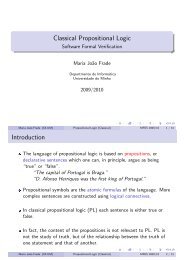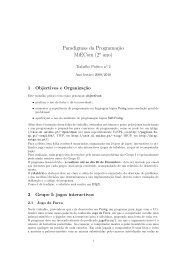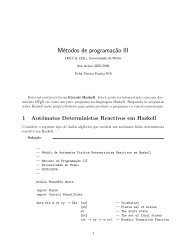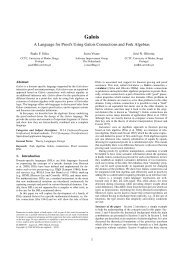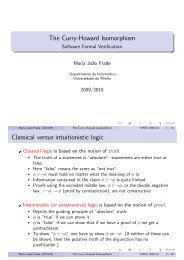Recursion Patterns and Time-analysis - Departamento de ...
Recursion Patterns and Time-analysis - Departamento de ...
Recursion Patterns and Time-analysis - Departamento de ...
Create successful ePaper yourself
Turn your PDF publications into a flip-book with our unique Google optimized e-Paper software.
Input list or<strong>de</strong>ring Tree Shape Anamorphism Catamorphism HylomorphismDecreasing / Θ(n 2 ) Θ(n 2 ) Θ(n 2 )Increasing \ Θ(n 2 ) Θ(n) Θ(n 2 )R<strong>and</strong>om △ Θ(n lg n) Θ(n lg n) Θ(n lg n)Table 1. <strong>Time</strong> <strong>analysis</strong> of the quicksort hylomorphismis now straightforward to analyse the time behaviour of the hylomorphism for each of the relevant cases, as shown inthe last column of table 1: for each input the asymptotic time of the composition is the sum of the asymptotic timesof the component functions, thus the function with the worst performance <strong>de</strong>termines the end-result.Mergesort. The anamorphism <strong>and</strong> catamorphism functions for this algorithm operate in a very similar manner toquicksort. The catamorphism behaves almost exactly the same as for quicksort, the difference being that the executiontime of its gene is linear with respect to the size of the resulting merged list. This means that its worst-case behaviouris also in Θ(n 2 ), but this occurs both for sorted <strong>and</strong> reversed input lists. The best-case behaviour now occurs whenthe intermediate tree is balanced, <strong>and</strong> it is in Θ(n lg n). This difference on the catamorphism si<strong>de</strong> does not affect the<strong>analysis</strong> of the algorithm significantly.However, there is a very important difference on the anamorphism si<strong>de</strong>, in terms of asymptotic behaviour: theinput list splitting process always produces sub-lists of similar sizes. This means that the intermediate tree that isproduced is always fairly balanced. In terms of execution time, this places the anamorphism function in Θ(n lg n) forall input list configurations, since the total work nee<strong>de</strong>d for constructing each tree level is in Θ(n) (a full traversalof all the sublists obtained from the initial) <strong>and</strong> the tree has lg n levels. Table 2 summarises the execution timeInput list or<strong>de</strong>ring Tree Shape Anamorphism Catamorphism HylomorphismAny △ Θ(n lg n) Θ(n lg n) Θ(n lg n)– / – Θ(n 2 ) –– \ – Θ(n 2 ) –Table 2. <strong>Time</strong> <strong>analysis</strong> of the mergesort hylomorphismcharacteristics of the mergesort anamorphism, catamorphism <strong>and</strong> hylomorphism for different input list or<strong>de</strong>rings.We observe that <strong>de</strong>spite the fact that the catamorphism function has a worst-case execution time of Θ(n 2 ), this hasno influence on the asymptotic behaviour of the mergesort hylomorphism. This is because the anamorphism neverproduces a tree that leads the catamorphism into its worst-case behaviour.Analysis of <strong>Recursion</strong> <strong>Patterns</strong>, Revisited. The examples in this section clearly show that when <strong>de</strong>aling with treesrather than lists, the conclusions of section 4 regarding the execution time of functions of the form foldr f c mustbe reassessed.It is clear from both the quicksort <strong>and</strong> mergesort examples that the complexity of the catamorphisms over binarytrees cannot be calculated mechanically from the complexity of the respective genes. The quicksort catamorphism islinear on the length of its first argument <strong>and</strong> the mergesort catamorphism is linear on the sum of the lengths of itstwo arguments; in both cases the shape of the tree dictates the behaviour of the function.In what concerns the time-<strong>analysis</strong> of the hylomorphisms, both examples are surprisingly simple, since theycorrespond to situations where function composition is easy to analyse: for quicksort, the worst cases coinci<strong>de</strong>,<strong>and</strong> for mergesort the anamorphism generates a single tree shape, which means that the evaluation context of thecatamorphism is such that its worst-case behaviour is never possible.6 Conclusions <strong>and</strong> Future WorkFor all the examples in this paper it was not relevant whether the un<strong>de</strong>rlying semantics was strict or non-strict.Consi<strong>de</strong>r however the following function that computes the smallest element in a list.


